All family eating fermented herring...
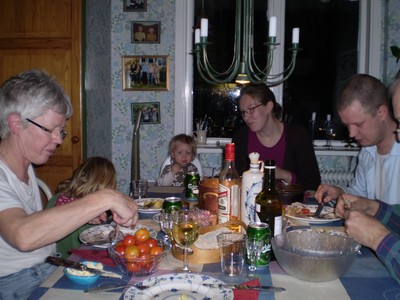
...a dish, popular in the north of Sweden, known for its terrible smell. You first hate it, then you love it - or you just hate it.
All those photo albums...
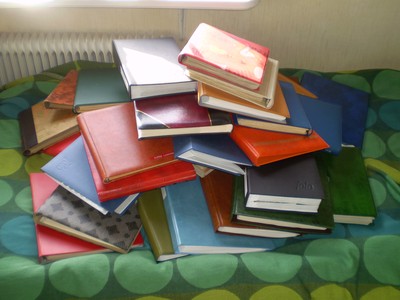
...we have at Skeda. There will be material for blogging.
Two nieces in a stroller
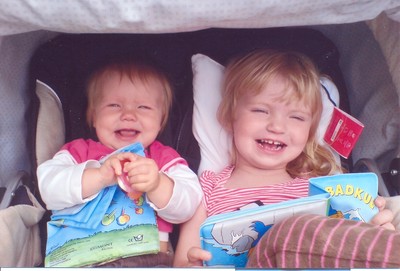
A mother working

A father working
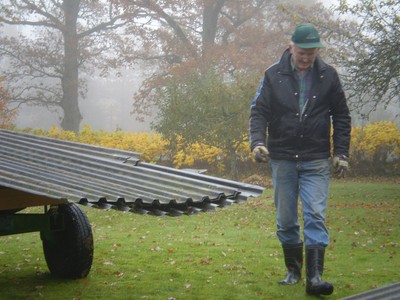
Talking about Gustaf Lindman...

...I found this photo of him together with my great grandparents Anna and Helge, Stockholm, 1914 (the same year that my grandmother Brita was born). Perhaps they are asking him for money?
This is the family archive...
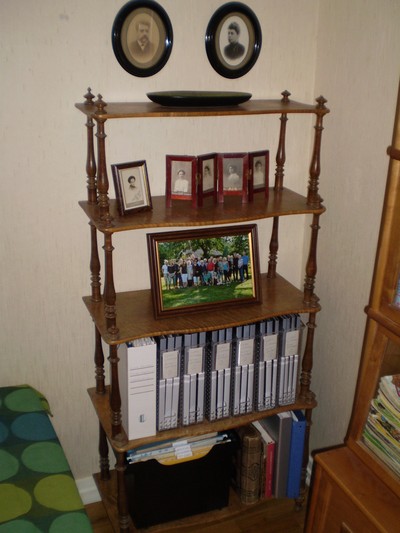
...where we have Lydia Lindman's correspondence (more than 350 letter pages), all of Gösta Wennberg's family stories, photos, films, chronicles and a lot of other documents. A minor research center for everyone interested.
This is a painting...

...of Gustaf Lindman (1866-1935), Salomon's younger brother, vice district judge in Jönköping. Because of the heritage they got from him, my great grandparents Anna and Helge could afford to buy Skeda in 1941. Financially, GL seems to have helped everyone in the family, or they used him. In other words, he was known for what he had, not for who he was.
Of course I live...
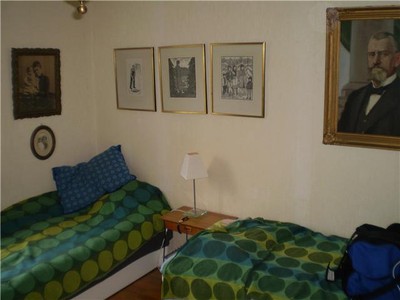
...in the family room.
The verandra from inside

I wasn't really sure if it was Skeda...

...but I recognized my parents when I came into the house.
In my Philosophy Blog...
...in all walks of life there are a few people who are compassionate, or generous, or honest, or intelligent, or wise, or gifted with some special talent. But there are more, far more, that are not. So the world is governed by false values: lip-service is paid to virtue and ability, but self-interest and cynicism rule. Human society is like a stage show in which most people are playing a part, a role, pretending to be someone they are not. But the show is an empty one, because life is fleeting, and for everyone in it the whole thing is soon swept into oblivion by death. The wise man sees all this for what it is, and is not taken in by it, and keeps himself uncontaminated by it.
My friend Niklas made the following comment: "This is a fantastic quote, it says in a few sentences what I feel is true about people. I like people who try to see through the stage show. I try my best to do it myself but sometimes you just get swept away by the shallowness of society. Lip-service is paid constantly. People look at the strongest individual in a group and then they try to emulate and copy that person's winning ways. Often with ridiculous results."
Isn't this very true?
A part of Swedish theatre history

When I was about nine years old I was watching a children series called Den vita stenen together with my grandmother. It was a scene where a man (the shoemaker) was playing some chair-game (sitting backwards jumping around) with all his children. My grandmother told me that the man who played the shoemaker was her second cousin. To me this was really grand.
The actor's name was Håkan Serner, a grandson of Salomon's sister Elisabeth (there are some interesting people coming from that branch). On stage, especially at Stockholm City Theatre, he was very active for many years and he also had parts in a lot of Swedish movies. He had a very personal way of acting: very modest, quite concerned but with glimpses of a subtle humour. In television he often read children's books, for example Winnie the Pooh.
He could have been with us today but he isn't. October 25, 1984, was the date of his death. He was only 51 and could have done so much more. Of course it was shocking to me when it happened. I didn't find out until later that it was his own choise (if we ever really have choises). A part of me is still sad because he is gone.
http://www.youtube.com/watch?v=AvexhszQnp8&feature=PlayList&p=67761E305923A620&playnext=1&playnext_from=PL&index=55
I must update myself
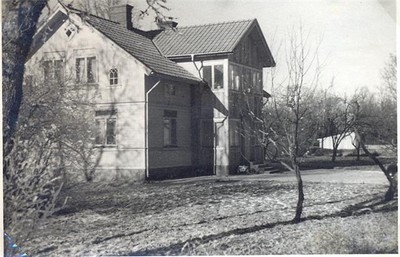
Maybe this is a more correct image today?
Next week....

...I will visit the family estate Skeda where my parents live. I haven't been there for almost four months, though, so I have almost forgotten what it looks like. Must use some pictures to refresh my memory. (Wonder if the car is exactly the same etc.)
This excercise...

...is quite fun. As a boss you are hiring a new co-worker. Suddenly, during the interview, you start to have tics or doing silly things. Or you even start to imitate the other person with a funny voice (in a really annoying way). The other person cannot do so much about it (mustn't laugh or do anything else) since he really wants the job!
Different kinds of acting
This is a question that I've given a lot of thought. What is the real difference between acting like actors do and acting like very sociable people do (sounding as if they were really interested in their neighbour's vacation etc.)? I have noticed that good "social actors" often aren't very good actors on stage (and vice versa), at least it is not the same talent. So what is the difference?
In 2007...
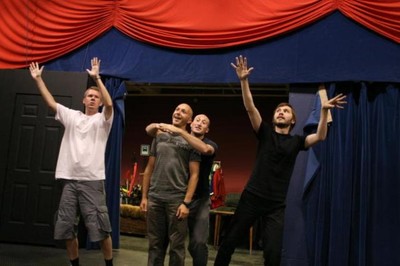
...I went to Calgary to attend a summer course (two weeks) in improvisation theatre. It was a good and interesting course. When I came back to Sweden I had quite a few new experiences and a booklet with excercises that I can still use.
But this course also made me understand that people outside Sweden don't have a warm meal in the middle of the day (which I find necessary); that theatre people (those on stage) are generally more intuitive and less analytical (I was quite frustrated sometimes) and that many people (at least in North America) are terribly afraid of showing serious sexual feelings on stage. They do it in a silly way because they find it so embarrasing.
Interesting that people who are so sociable and physical (like to hug etc.) still don't want to show themselfs really vulnerable. Backstage I was the most introvert, on stage I was the most extrovert.
Gösta wrote a lot of poems...

...and during 2010, when he would have had his 90th birthday, I will translate some of them and publish on this blog.
Those two persons...
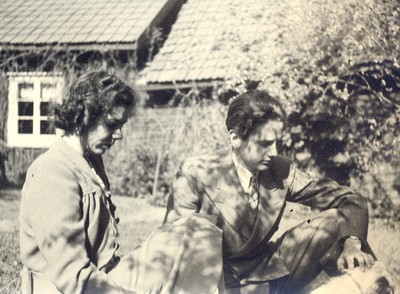
...I remember in a warm and pleasant way. It's my grandmother Brita with her brother Gösta outside the house in Värnamo in 1939. As siblings they were both alike and unalike: Brita was more sociable, Gösta more analytical; both were cultivated, well-read persons. Both, as far as I know, had happy marriages and lived quite long lives (89 and 84 respectively).
When I see the picture of Gösta petting the dog I cannot help thinking about his dislike of cats (some people just hate the feminine traits that others find appealing). One Christmas in the late 80's he sent us a letter where he wrote: "A Merry Christmas to Brita, Margareta, Björn, Hans, Lars and all the sheep and the hens! And possibly the cats."
Talking about voices...
Margaret Finnell
Dick Ring (voice still active)
Brita Sjögren
Anna Wennberg
Else Wennberg
Gösta Wennberg
Signe Wennberg (Anna's cousin and sister-in-law)
What more do we have?
This is my aunt...

...Birgitta Mossberg, Secretary General of Ronald McDonald Childhood Foundation in Sweden. In the summer of 1986, visiting Skeda, she borrowed my tape recorder and interviewed her grandmother Anna, 97, about her life. Initially, though, she interviewed her mother Brita who could give us the storyline.
As a result of this, we now know (among other things) how Salomon and Lydia met each other, what really happened when Gunnar Serner tried to kiss his cousin Anna, how Skeda was found and bought and how a bunch of kids came to live with Anna and Helge in Värnamo. We also have both Anna's and Brita's voices saved on a tape. Well done, Birgitta!
Audio file: Anna's story about Greta's children coming to Sweden
This drawing...
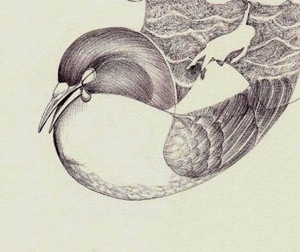
...was made by Jennifer Ring. Her grandmother Kerstin was ill for a great part of her life; she had a so called rheumatic heart. There has been speculation about this condition being caused by Kerstin being "dropped into cold water" as a child. When Jennifer heard about this she made two sketches of which this is one.
According to my great grandmother Anna, the incident took place at Österängen's farm when Kerstin was about one year old and nearly drowned in a stream outside their house.
What if Kerstin really had drowned. So much would have been different. There wouldn't have been a Torsten, nor a Marita, nor a Dag, Vivianne or Eva-Karin. Reginald Ring would, sadly enough, have had to find another woman to marry. And I wouldn't have had anyone to visit when I went to Canada this summer.
In his blog...
Such father, such son...

...well, not really. We are very different. But there are similarities. When the two of us are having a discussion, which involves exaggerations and sounding very very angry, no one can doubt that we are related.
When I was eight my father taught me to play chess. I was a fairly good player at amateur level. This photo from 1984 shows the two of us sitting in Skeda's garden. This was about the time when I started to beat my father, I remember I beat him 12 times in all. But I still don't know if it was because I was really better than him, if he let me win or if he was just tired of the game.
Yesterday I had a letter...
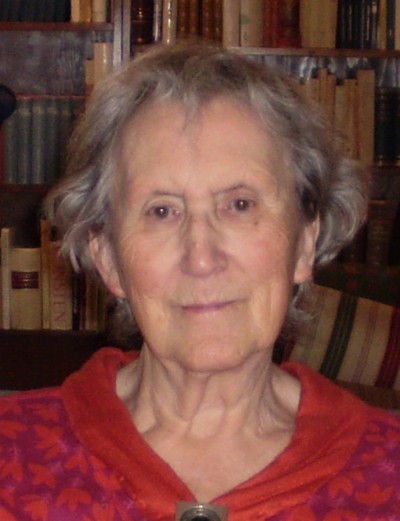
...from the oldest person that I know: Maj Aili, nee Rydsjö, born 1915. She is a sister of authoress Elsi Rydsjö, granddaughter of Salomon's sister Elisabeth and second cousin of, for example, Dick. I met her for the first time at Skeda in the 80's, kept in touch with her and visited her in Halmstad for the first time in 2006. (Under Other Documents/Övriga dokument there is a letter from Greta Lindman to her cousin Signe Rydsjö, where Maj is referred to as "the girl with dimples in her cheeks".)
It's interesting to listen to her recollections since she (among other things) has stayed one year in the 30's at Rosenlund, Jönköping, keeping Gustaf Lindman (Salomon's brother) company. She has also spent at least one summer at her uncle Gunnar Serner's estate (a famous author, cousin of the Lindman sisters). She remembers so many people from the past and it really feels special sitting and having coffe with her.
I have asked myself why I generally feel so comfortable meeting old people. A part of this is their calmness following an accomplished life. Talking to an old person you don't really have to proof anything.
Those two girls...

...are Sienna de Bartolo (born 1993), daughter of Barbara Young, and her cousin Kyla Weinrib (born 1993), Julian's sister. They are my third cousins. How many people ever get the chance to meet their third cousins and be aware of it? (Photo by Kerstin Ring.)
This is Julian Wienrib...

...her great great great great grandchild in Toronto, born in 1980; son of Nancy Young, grandson of Louise Ring, great grandson of Kerstin Lindman. At the family reunion at Barbara's this summer, I met him very quickly but didn't really have the chance to talk to him. Hopefully I will in the future. (Photo by Kerstin Ring.)
And this, ladies and gentlemen...
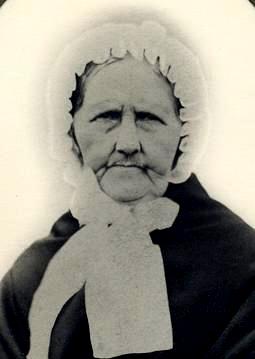
...is Mathilda's mother Christina Pihl nee Lengquist, my great grandmother's great grandmother. She was born in 1790 and lived to be 92 years old. (I remember my great grandmother Anna making a comment on this: "That was nothing!" Herself she lived to be 98.) Just like her daughter she was married to a priest and just like her daughter she survived her husband by 51 years.
When it comes to family history, women are more interesting. Because the men die earlier, are less complicated and write less letters and diaries.
This old lady...
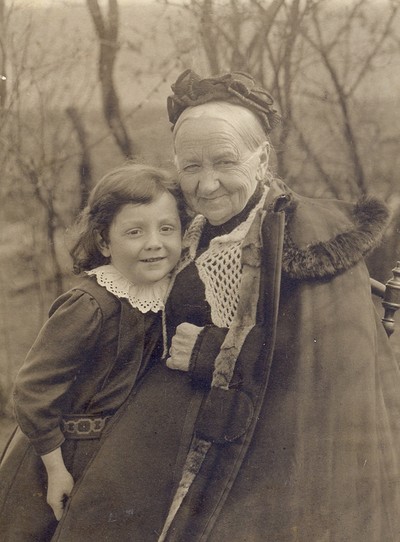
...is Lydia's mother Mathilda. She lived to be 91 years old, surviving her husband by 51. (As we know, it's a beloved tradition in our family to survive one's husband.) According to the back of the photo, it's together with her grandson Torsten Ek. But doesn't it look more like a girl? I don't know so much about the fashion of 1910, but a boy going to school in those clothes today would hardly come home alive.
The inscription:

O.C.T. Andrén, born September 21, 1824; dead June 11, 1870.
Lydia is buried in the same area but doesn't have a gravestone. Maybe her descendants could give her one? Thanks to Marita and Sune for the pictures.
And this is his grave...
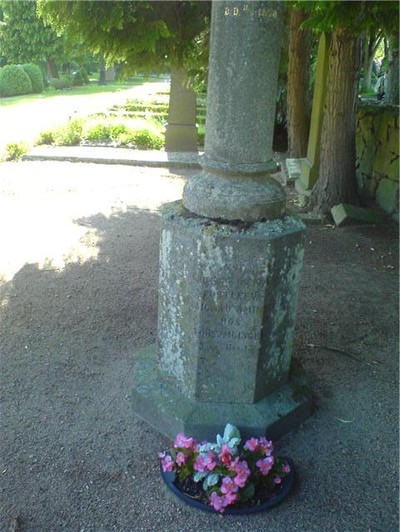
...at Asarum's churchyard where he served as a vicar the five last years of his life.
This handsome man...
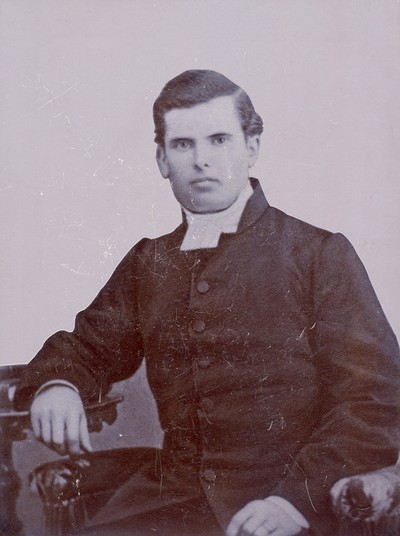
...is Lydia's father Olof Christian Telemak Andrén. According to the people who knew him, he was (as a person and as a priest) someone that you really would respect. After marrying Mathilda Pihl he went to Moline, Illinois, USA where he was one of the founders of Augustana Evangelical Lutheran Church.
I'm glad that he did for because of that there is a book about him: Olof Christian Telemak Andrén, Ambassador of Good Will. My aunt Anniqua has it and when I have read it I will write an essay about my great great great grandfather. Honestly, how many people can do that?
